#comic advice
Note
if i may ask, is it difficult at all to re-edit/organize the comic pages from the webtoon format to fit the graphic novel format?
on another note, I'm so happy that your kickstarter was funded!!! I love time and time again, im so excited to see this all happen <3
I'll just turn this ask into something of a guide for the process! Because yes, it is difficult, but there are also many ways I have been preparing from the beginning for this very situation to make things easier for me!
I've worked in both print and scroll in the past, and have done this transition once before for a short story, so I already had familiarity both with my goals for print, and struggles with the transition!
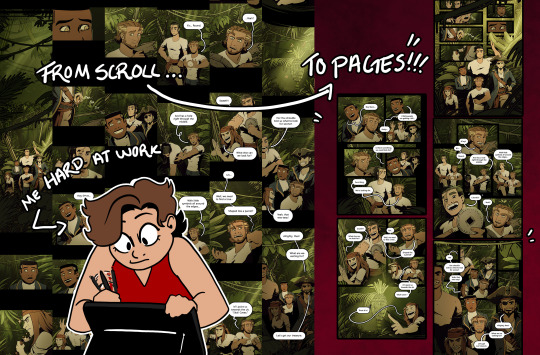
How I prepared from the beginning for this transition:
1: My panels are 2500 pixels wide, so they can span my page (which is 8.3x5.8 inches) at 350 DPI (which is print quality)
2: My layers are organized: Text, FX, Foreground, Characters, Background

3: I draw one very large (twice as big as any panel would be, minimum) background for my major locations, as well as drawing furniture assets in isolation. This not only saves me time when making my actual episodes, but it also offers me INCREDIBLE flexibility when making this transition to print.
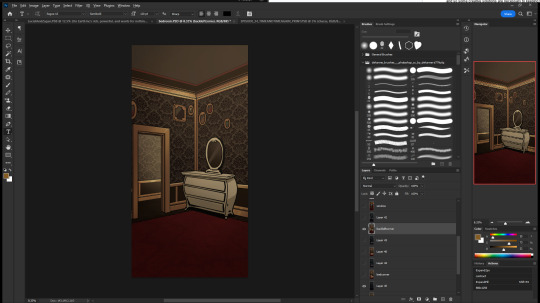
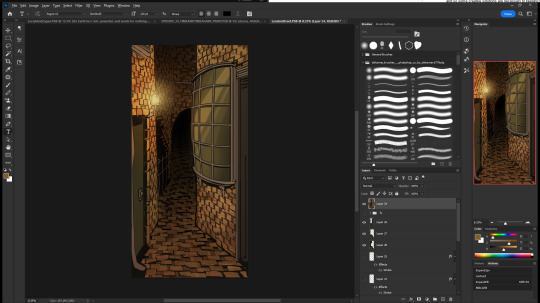

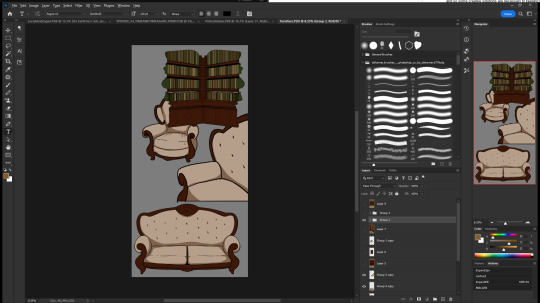
These 3 things let me pull the character art to the page by itself, scale it up or down to fit my panel, and then fill in the background behind the character.
So, I read the scroll version, decide how many and which panels I want on the page for the pacing (I also keep page spreads and page turns in mind while I am doing this), and then I pull those panels over from the scroll version to the page.
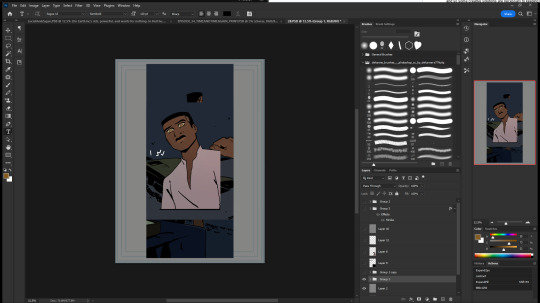
Then, I make the panel borders/page layout that I want, fit the character art into it, paste in the backgrounds, do any art editing that I need, add FX, and then re-do the text!


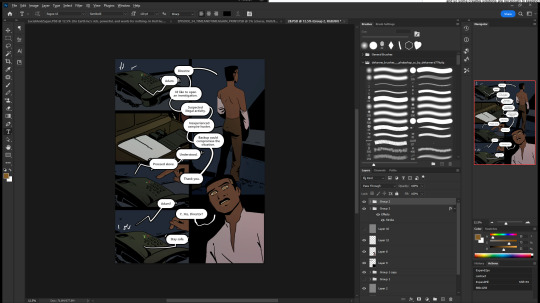
Sometimes I do need to draw parts that are missing (shoulders or elbows getting cut off is an extremely common one) and sometimes I need to adjust facial expressions, cut panels, or rearrange panels to make things read more clearly. Since it's my comic already, I know how to do these things while maintaining the original intent, but if I were working with someone else's comic I would need to work closely with them to know what can and can't be cut.
(original panel vs an expanded version)
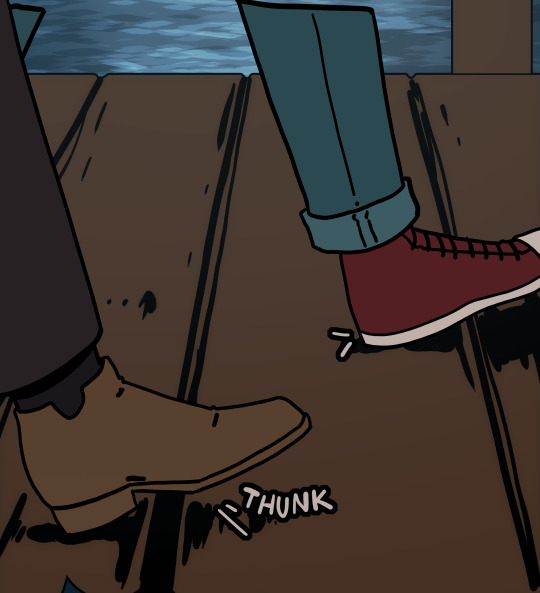
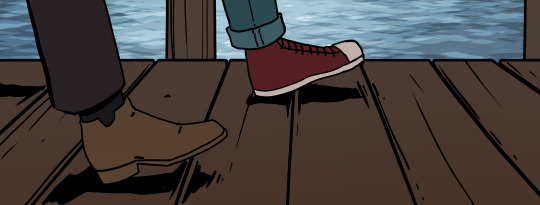
Another common issue is that VERY tall panels will inevitably lose a lot of information when they’re turned to pages. Identify the purpose of the panel (pacing, showing a lot of detail, etc) and then replicate that with your page layout.
examples (in order) are: scene transition, being overwhelmed, suspense, and establishing shot. All of these were a single panel in the scroll version!


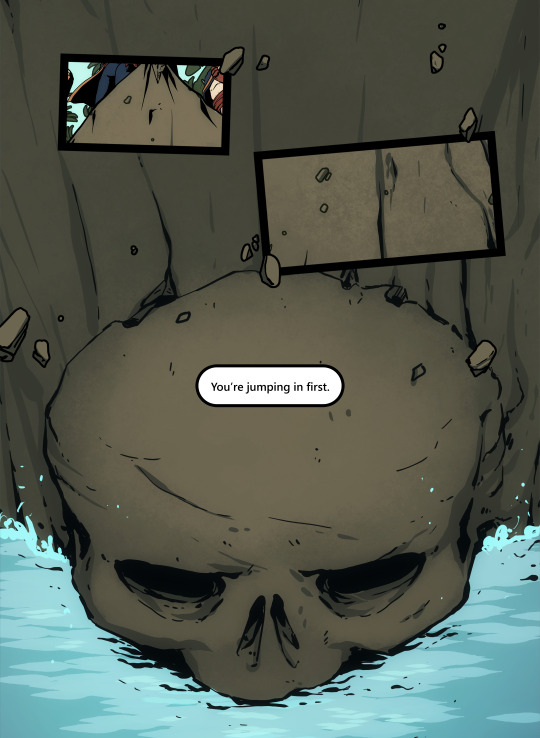
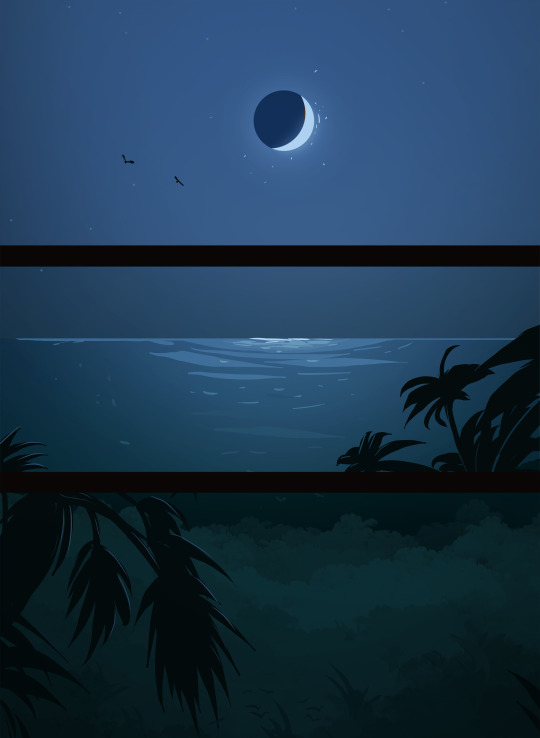
Another issue when converting pages is that panel order is a lot less straightforward than when starting from print format. Conversational back and forth that's fine in scroll often messes up the flow of reading in a page (characters facing out, not looking at eachother from panel to panel, etc) and so some creative solutions are necessary to keeping the reading order.
For the first page I had to delete and rearrange some panels, and in the second the dialogue bubbles guide us to read this page in a circle. (dialogue guides through a lot of my pages lol)
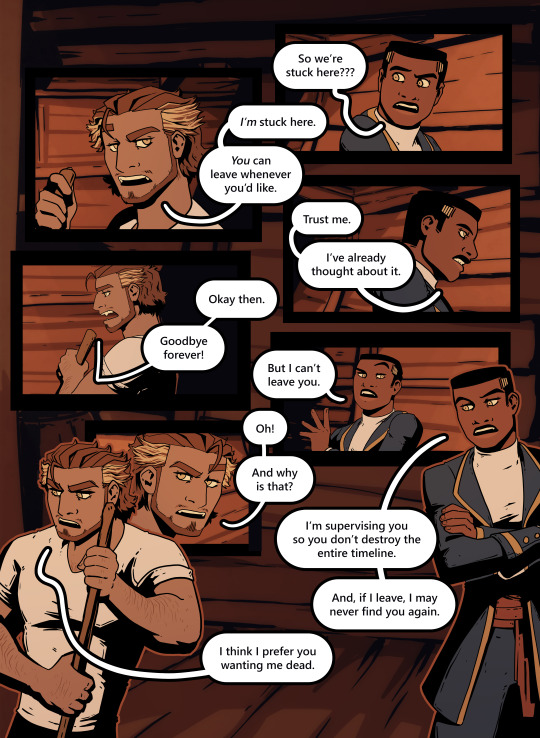
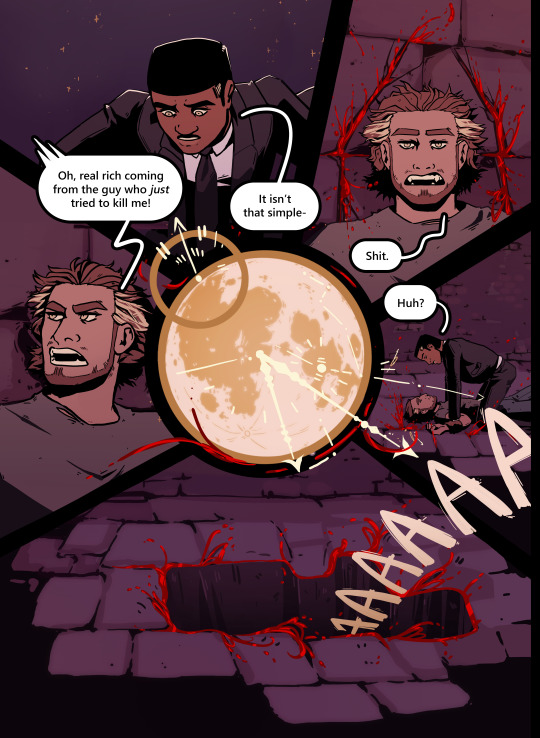
And the last really common issue that pops up is that height differences can be really difficult. Usually in print this is solved with clever angles, but I’ve already drawn everything. So, I’ll either resort to vertical shaped panels, panel pop-outs, or editing a character up or down to fit into the panel.
(examples in order)
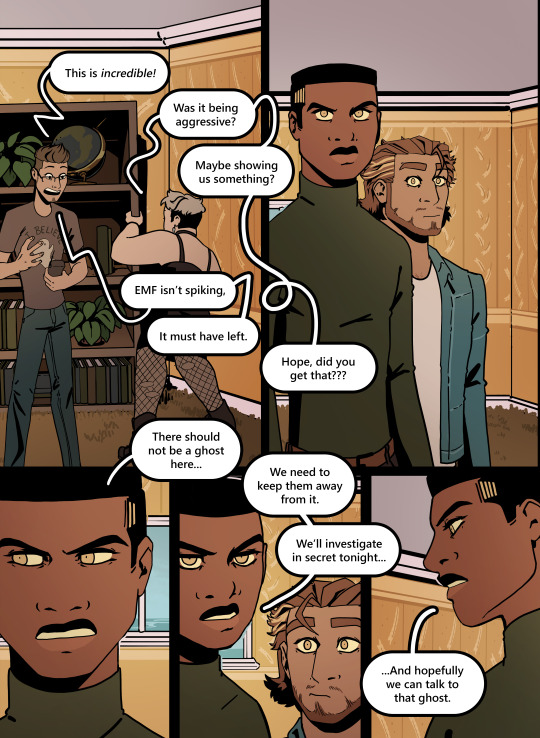
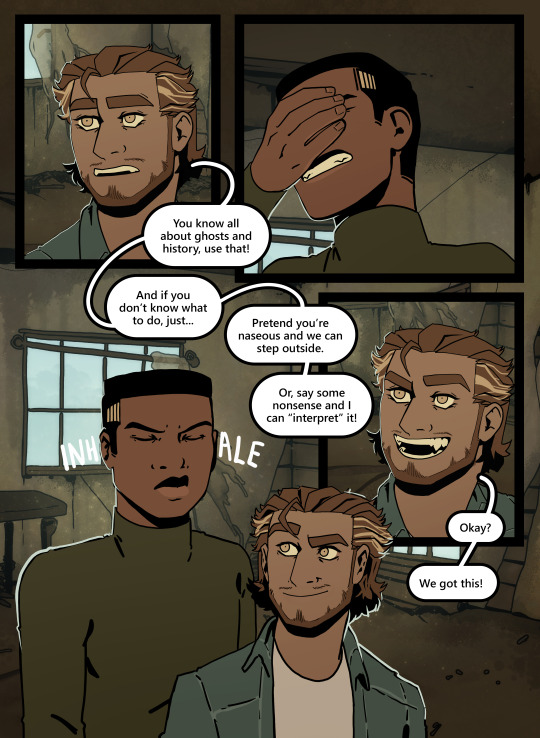
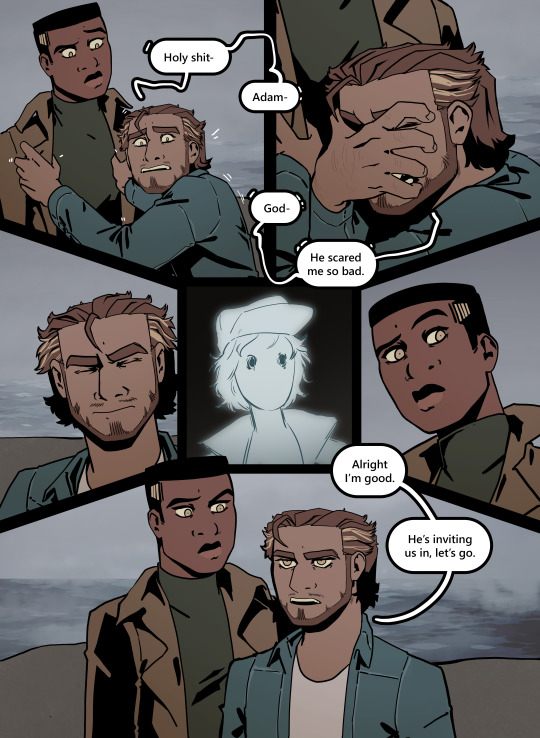
So, yes, it is difficult! But I have a lot of experience with both formats, and having prepared for this from the beginning I've been able to make the transition a LOT more smoothly than I otherwise could have.
I hope this helps!
And, thank you about the kickstarter! I'm extremely excited I'll be able to print these, the proofs I've received so far look just absolutely stunning and I'm so so so excited to get to send them to people!!!
Obligatory self promo, if you want to see the kickstarter page and get these four books for yourself, then you can check it out here ^^ It's been funded, so at this point we're just reaching stretch goals and placing orders!
#asks#anon#art tips#comic tips#web comics#comic books#comic advice#also this is just my own experience obviously everyone works differently and I cant promise this will work for you too#but doing things this way I've been able to finish about an episode (15 pages or so) every day#so it's been extremely swift (though also of course a ton of work)#thank you past me for making this so easy!!!#it'd easily take 5x as long without the prep I did!!!
165 notes
·
View notes
Text
i STG i had an ask asking about how to format comics / advice,, but its vanished,, I must've accidently deleted it so OOP
have some scuffed comic advice ig??

so heres a very very basic comic, very much how I used to format my comics when I was younger
the problem with it is every panel is a bust shot, so all the panels look the same

one way to freshen up your comic is to change the style of shots! kept one close up, but then I changed one to over the shoulder and one fullbody shot of both characters
also sticking to the rule of keep characters on the side they're shown, unless you show a panel of the characters moving from one side of the panel to the other

if you're struggling to figure out what shots to use you could always put everything into one panel, means you have to draw less lmao
full page comics with multiple panels is a bit different, and I'm not experienced in them so I cant give advice for those lol
Lemme know if yall want me to explain how I do anything else for my comics/aus! I'm mostly making it up as I go along but I can try to explain to yall my thought processes lol
44 notes
·
View notes
Note
hey, so a lil help is required... got any tips for making a comic? if you can't help me with that, how do you keep drawing after you draw one thing. (lol, HELP ME)
I've answered what my own comic development has been like before, in some older asks. (And some other ones that are lost forever in my blog q-q)
Regarding my own tips for comic making? Hmmm...
My main take away would be to have FUN!! Your enjoyment drives the story forward. It is important, not just for the comic, but for YOU the artist! :D
don't stress too much over a comic's quality or quantity :) your art is not a fast food truck <3 And your friends will like it anyways
I recommend starting on small ideas you have! You could make some doodles before you actually start making a comic. This may help you feel more attached and/or interested in the story :) It could even flesh out stuff you didn't think about previously!
Having trouble drawing so often? Draw "one-shots"! This can include small snippets of major events you want to see in your story!
Don't be afraid to tell your ideas to ur friends! Ppl will love hearing creative ideas
Thats some tips i've found that really help me. I hope you enjoy the art of creation ;)
43 notes
·
View notes
Text
youtube
Not exactly writing, but an art tip for my webcomic creator followers :)
#webcomic#indie comic#comic#comic advice#comic tips#art advice#art tips#rightwriter#youtube#manu mercurial#Youtube
45 notes
·
View notes
Note
I’ve been wanting to try a hand at making comics since I think it’d be the best way to tell some of my stories- but the thing I tend to have the most trouble with is the actual layout and composition of panels.
do you have any tips/tricks or resources that might help me get a better understanding on what to look out for, think about, or even just start? I’d really appreciate it!
That's something that'll just take time and practice, honestly :'0 Sorry that's probably not a very satisfying answer but there's a reason why the answer to so many "how do I get better at xyz" questions is "practice" LOL That said, there are ways to help you practice, I think in the case of composition and layout the best way to do it is go read other comics! See how they set up their panels, how they vary them, how they push the limits of the boundaries of the panel and page to emphasize characters and speech bubbles, etc. It also depends on what kind of story you're telling, as composition is just as much a conveyer of information as the characters and art. Different genres and mediums of storytelling will use different compositions to reflect that.
I'm gonna use BONE as a starting point. It tends to have pretty easy to read panels as these books are meant for all ages and the art is designed to be easy to read-

-but they also get fun with them sometimes:
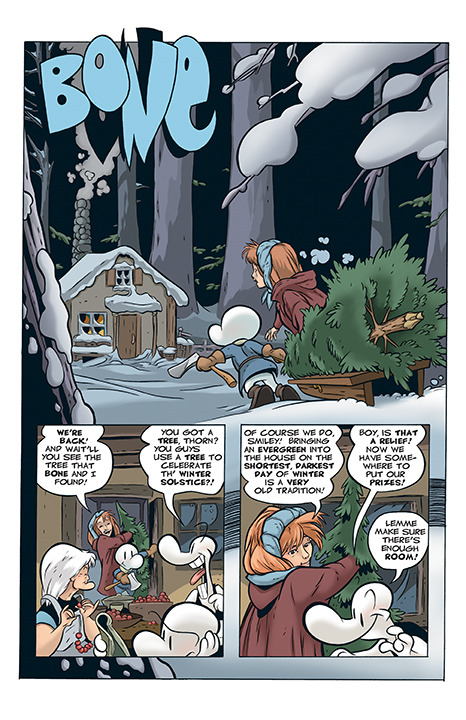
BONE tends to focus on per-panel art pieces so it just makes it look a lot nicer than if they had cut the panels up individually when they let the previous panel operate as a backdrop like this.
And then there's shonen manga, which tends to be way more focused on action and movement, so the panels reflect that. You'll find a lot more panels cut up into unique shapes to convey movement and action in manga like Naruto and Berserk.


And then you get REALLY crazy shit in stuff like Tales from Alderwood where the characters break the panel line entirely on a regular basis.




If I can use some of my own pages as an example, here's stuff I've done with my own compositions:


Really it's just treating the page as a composition, and each panel is a different aspect of that composition. Narrow down what your goals and focuses are when it comes to depicting a page, and look at other works that are the same genre/medium as what you're doing, there's tons of inspiration you can get just from reading alone :)
48 notes
·
View notes
Note
Are there any general tips you can give to artists who want to make an OC comic? Like anything they should do or avoid?
The biggest thing i would say is to make the story you are passionate about. Be as passionate and unhinged about your creation as you want to be, and create a story that you want to read.
I know some people try to make stories that are marketable and that will get the most views, and if that is your goal that is totally fine, but I know I personally need to be completely invested in what I'm doing. Comics take so so much time to make, I wouldn't want to dedicate this much time to something I wasn't passionate about, you know?
I can't give much tips on how to make comics specifically, all comic artists have a different method. I like to work with a general plot summary and plot script / rewrite as I go, because that keeps me engaged with what I'm doing. While other folk like to have an entire script done before starting.
Some folk like to wait to post until they have 100 pages done, I like to wait until I have 10 pages done. Different things work for different people. Good rule of thumb for a backlog is to have enough to post for a month without drawing. If you upload 2 times a week, have an 8 page backlog. If you post 5 times a week, have a 20 page backlog.
Other than that, I really feel comics is a "you gotta do it to find what works for you" sort of deal.
oh and dear lord take breaks, don't kill your wrist or back, take care of yourself.
53 notes
·
View notes
Text
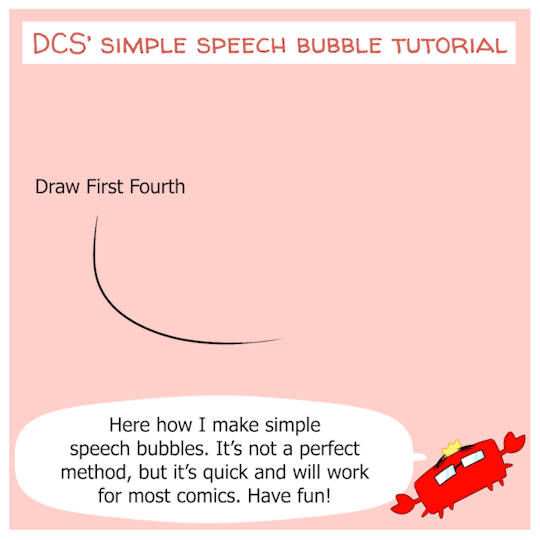
Quick bubble tutorial I made!
18 notes
·
View notes
Text
Looking for some advice on webcomic hosting! I hear a lot of different opinions. Should I just host on my own website or should I host on webtoons/tapas? Both?
11 notes
·
View notes
Text
hello peopel of tumblr, i have a qualm id like you to help me absolve, im making a junji ito inspired comic, should i mkae it read from right to left or left to right?
11 notes
·
View notes
Note
do you have any tips on story writing / comic making? ive got something all plotted out but i just dont know where to start with executing it
hmmm this one is tough because i have a long history of starting and giving up on comics, even if i have a full script written out. i'm personally really bad at the whole planning-stuff-out thing. i tend to work in short bursts and write stuff maybe two or three scenes in advance.
i think my best advice would be: if you have something planned out, and you're excited to start working on it, just start working on it.
don't wait to find the perfect beginning, because in my experience, you'll eventually lose confidence or motivation if you wait too long. the worst thing that will happen is you might come up with a cooler idea later, but the good thing about webcomics is you can always start over, especially if it's early on. my "main" comic- something ive been working on since 2014- i have started and stopped about 6 times, and i have changed the plot/settings completely about as many times. i even wrote it out as a 100+ page novel for a creative writing class in high school. i actually started SBC with the intention of doing a short 1-2 year comic to kinda "warm up"
share some of your process online and with friends for feedback as you go with pre-planning. when i was building up the mojave clan concept, briskwater was intended to be the main character, with vulturepaw, a sunclan cat, having an unrelated but major side story but when i shared my first character sketches with my friend server, they all went bonkers over Saltburn so i changed my plan to focus on her. you don't have to share everything, but just having people initially interested in your story is a HUUUGE motivation boost.
if you're having troubles scripting a start, don't script. think about openings to shows/series that you like and just start sketching stuff. i really like the foreboding prose-like openings of Fellowship of the ring and Avatar the last airbender, that tells you everything you need to know about the world itself, and mayhaps foreshadows a bit, but is still opened-ended enough that it can go anywhere. you can also start in media res; AKA start where the action all ready happened/is happening, and do a "teaser" of sorts, and then go back, sometimes called a Cold Open (tho that one is used mainly in TV, and some argue it's different but they're both functionally the same thing). think about how procedural investigation shows will often show you an obscured view of how the episode's victim gets murdered/kidnapped/whatever, and then it launches into the shows opening credits.
also finally, and i mean this so, so genuinely, it does not have to be perfect, and it wont be. you are going to be drawing SO many characters so many times, so many BGs ect, things are going to slip through the cracks that that's OK. you can take shortcuts, you can be lazy, you can have continuity errors. also give characters in the BG funny stupid faces instead of worrying about details because its fun to do


sooo yah. that's all i got
TLDR: look at intros to media you like, and steal their style. don't worry about getting it perfect. if you have even a slim idea of what you want, just go for it and it will come to you. if you don't know what you want.... also just go for it.

also. my style of writing/comics works for me, but it might not work for you so take any advice i give with a grain of salt. ask other comic folk, like @razmerry and uh. ive been sitting here for 15 minutes but i literally forgot every other comic person ever. so sorry. but anyone who knows things feel free to add on.
#im not really the best person to ask for advice because im so scatterbrained#i also dont script stuff line by line#i typically come up with the full dialogue on the fly#comic writing#comic advice#idk what to tag this as
59 notes
·
View notes
Text
Writin’ Comics and Junk: Part 4 - Comic Compositionin’ (Part 2)
It sure looks like things have finally begun to pick up in our ongoing saga of heavy metal people and their friends! Things just get more interesting from here, so don't miss the next one!
The next Dethkomic update will be
Tuesday, April 25th, 2023!
At this time, I'd like to give a special shout-out to all of you who have offered up your OCs to the Dethkomic overlords! I'm working on getting everyone's cameo appearance into the book for issue #7!
Right now, though, we have another comic book tutorial to share. It'll be a briefer one than usual, today, but covering a very important part of comic book composition, regardless!
The Art of Sequential Direction
Last week, we covered the general aspects of comic book layout, so I thought this week would be a good place to go over the more detailed bits that make up the panels in a page. Check it out below the cut!
Take a look at the two page layouts, below. Which is more interesting to your eye, at first glance?
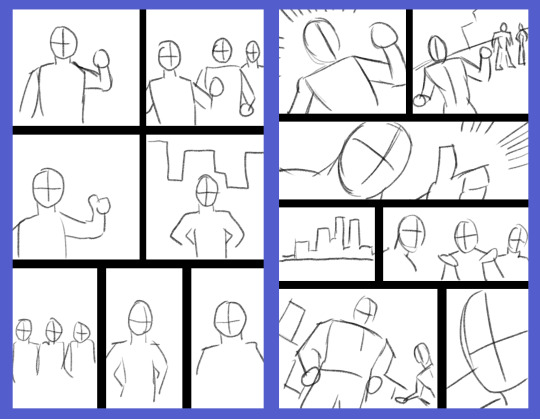
The first page doesn't offer much in the way of variety, while the second page is chalk full of it -- it's not hard to understand why the second example looks and feels more exciting to read.
One of the things I tell creatives who are starting out in comics, who usually are coming from a background that's full of one-off pieces of art and very little sequential work, is that comic books -- especially action/adventure comic books, work best if you look at them through a director's eye.
This was one of the first things that was told to me as a young comic book artist and fan, and it's something of a never-ending journey. I love to watch movies and shows while my mind picks apart what the director was trying to convey in the way the camera was set, how the scene pans or stays still, what music was playing, how the dialogue carries -- all of it! Comics may not have as many moving parts as a movie, but you can probably guess that when it comes to conveying emotion through scene-setting, they are basically the same.
Just like the movies, comics have some ground rules that can help you make them more inviting and simultaneously exciting for your readers. Each one of these isn't terribly hard to do, but you'll be amazed at the impact they can have on your comic. I have three very, very simple ones that you can do, immediately:
Change the Size of Your Characters.
The above advice was handed to me in the same era, if not the same week, if not the same sentence as the advice about looking at your story as a director. One of the easiest things you can do and indeed, one of the most important things you can do -- before you even start to get a grasp on what types of scenes evoke what type of mood (we'll get to that...) --is to change how big or how small your characters appear, panel to panel. Basically -- pan the camera out, or in. Your readers' eyes will be far more likely to stay focused on what's being said and what's happening, if the scene changes just a little bit in this way.
Change the Camera Angle.
That horizon line that tells us where the end of the world is? The one that separates the ground from the sky? Move it up or down, chief. That's it. That's all there is to this one. Sure sets the scene differently, doesn't it? Notice how your characters, no matter what size you drew them, now look either really big (if your horizon line is low) or really small (if the line is up high) in the panel. That's what we wanna see -- make those guys change size!
Change the Panel's Tilt.
Okay, so now some of your characters are really big on the panel while others are small, and your horizon is way up, way down, or completely off the panel! Good work. Now pick one or two panels and turn them at a 45 degree angle. Or a 90 degree angle. Or if you're really bold and are making some kind of statement, turn them upside-down. Especially the panels where you're going to have trouble fitting the necessary dialogue balloons in -- this is a great trick to find yourself some more space.
Now that you have those down, you have a go-to for when you are just dragging it on finishing a page. Especially the pages that don't offer any particular points of interest and are just there to move the story to its next, more interesting part (shoeleather, as they're sometimes called). Even boring pages can be made way more interesting with the use of those three easy tricks.
Getting into the nitty-gritty, comic book professionals have a wide variety of shots that we typically fall back on when it comes to directing our stories. Each one can be used for different purposes, and to convey a different message. Another piece of advice given to me early on, was to treat my comic pages as if I had to tell the same story that was written out, but without the dialogue. If I could do that -- if I could look at what I'd drawn and get a good impression of what has happened without the characters saying a single word -- that was a good indication of a successful page.
So what are these types of shots and how do we use them? While this is by no means a complete list (Just google "types of comic book shots" or similar), I'll do my best to examine some of the more common ones, and give examples:
The Establishing Shot:

In the above example, we can see that Nathan is head of the table, in Charles' usual spot. Dethklok is on one side, Baen-Shee is on the other, and Toki isn't shown, but that's the joke -- he's so far away his speech balloon is coming from off-panel. Murderface is conspicuously absent. Establishing shots are important because they show the reader, at a glance, where everyone is and where they are in relation to one another and their environment. You should strive to have one establishing shot per-scene. Some people say per-page, and I think that's also good advice, if not a little extra work.
The Long Shot:

Oftentimes, long shots are establishing shots. The camera is far enough away from the subject that it gets most of/all of their whole body in the panel, as well as a good chunk of the environment. This gives both entities equal "weight" in the storytelling. What's that? Did I just call the background an entity? I sure did! Remember that.
The Medium Shot:
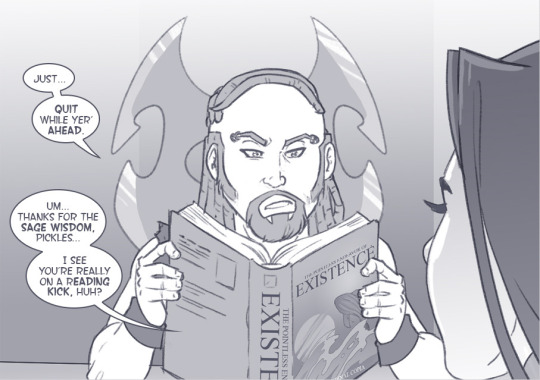
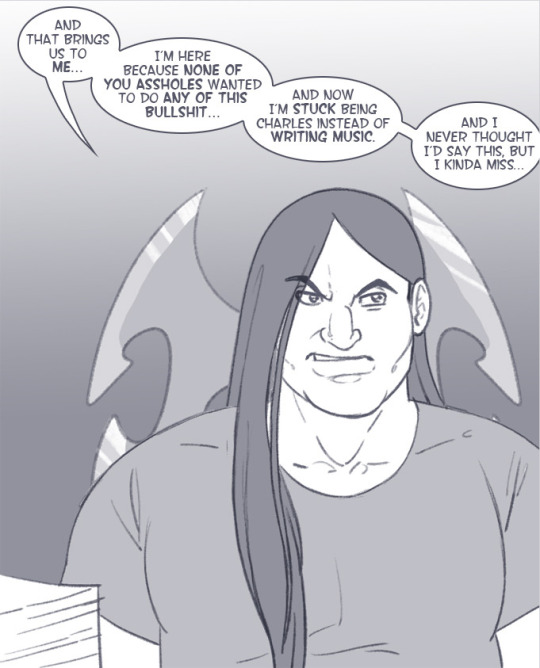
A pretty standard shot. Here's a guy. He's talking now. Maybe he's saying something important, and maybe he isn't. Whatever is happening, it's not doing it with great impact, and that's the point. Use these basic halfway-up-the-body angles when you're just establishing that something is being said or done, and by whom.
The Close Up:

Now it's getting interesting. We're zeroed in on one or two characters' faces to the point that we're forced to consider their facial expressions above all else. Must be some real tension going down, here.
The Extreme Long Shot:

Hey! Where'd my freaking house go??? Sometimes the environment is more important than the characters in it.
As I said, these are but a small sampling of all that's available to you as a comic book creator, when setting the scenes in your story. Next we meet, I'll go into some of my thought process when it comes to putting a page together and how I'm making decisions regarding the flow of the story, transitioning, layout, and more.
See you then!
20 notes
·
View notes
Note
Any tips for a newbie trying to write a comic?
maybe...
Start now!!! Perfect will never come. A year from now you'll have learned more than you ever would have by waiting to be good enough to let yourself start in the first place.
Starting small is generally good advice, but really you should start with the story you're actually excited to make.
Every scene is there to accomplish a specific goal, and that goal CAN be accomplished in more than one way. Don't go ahead with a scene you don't love because you "need" it. Plan ahead, and edit with a machete.
If you don't love a scene, your readers won't love it either.
You have to be your number one fan, keep your number one critic to yourself. Putting yourself down doesn't make anyone want to read your comic.
The process that works for you is NOT what will work for others! Be patient with yourself as you figure out what does work, it takes a long time.
Clarity is far more important than anything else. Your comic doesn't need to be gorgeous, what it NEEDS to be is clear, direct, and effectively show the reader what they need to know.
Characters need to show their emotions and actions
Backgrounds need to tell us where we are
Paneling needs to show us which order to read things in
Using photos, 3d models, or copy/pasted assets is all perfectly fine and acceptable. As long as you own the rights to use the images or models, you're allowed to use them however you see fit. It's not cheating.
Do not start making comics for money
Don't start making comics for fame
Comics aren't a stepping stone to adaptations. If you want an animation, make an animation.
Get into comics because you love comics and you've got a story that you simply can't go another day without telling.
Make comics!
#writing advice#tips#writing tips#comic advice#I love talking about this stuff. I've got plenty more tips but this is getting long already lol#there's so much to comics#theyre so wonderful#make them#learn#and in a year you'll have something wonderful#comics changed my life.#make comics!!!#asks#writing rambles
317 notes
·
View notes
Note
A question if you dont mind! How did you go about making the website for THOAM?
it was super easy!
you just need to sign up at https://comicfury.com/ and the site has templates and pretty much all tools you need to make a site for a webcomic
34 notes
·
View notes
Text
My dumb ass just realized somthings
you know when you ask a seasoned comic maker for advise and they say to start small but the thing you really want to do is a big thing that you are having a hard time putting on paper.
Solution
Make smaller origin comics for your characters so people know the characters in your bigger comic and so you have a clearer vision of their character/backstory and it's a good bite sized comic project to dip your toes in.
6 notes
·
View notes
Photo
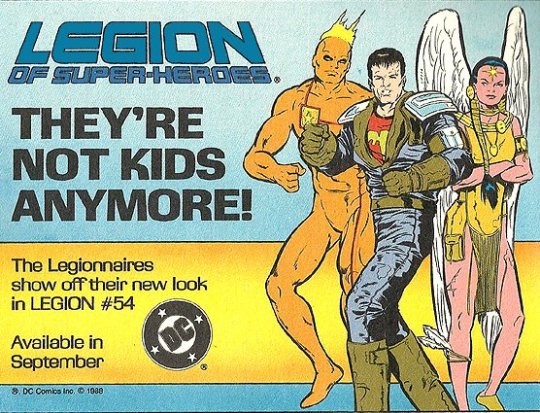
1988 Legion of Super-Heroes Vol. 3 #54 DC Comics House Ad
#1988#legion#the legion of super-heroes#legion of super-heroes#keith giffen#paul levitz#print ads#comic house ad#comic advice#dc#dc comics#dc comics house ad#dawnstar#ultra boy#wildfire
23 notes
·
View notes
Note
Hello! I really love your Lore Rekindled project! Persephone's characterization is especially great and the art is wonderful (kudos to you and banshriek)!
For a big project like this, I am wondering if you ever have to deal with perfectionism and the need for every panel to be perfect. I suffer that problem everytime, always stressing over how my art looks.
Do you have any tips on dealing with that? Or just personally, how do you deal with it?
Thank you!! <3
I have a weird relationship with perfectionism. On the one hand, I tend to catch itty bitty mistakes n such that I can't rest until I fix, but on the other hand, I've been at this so long now that I've learned to accept when things can't be perfect all the time.
Case in point, old pages of Rekindled are already starting to look like ass to me, but I remind myself that that's okay - because if it didn't look like ass, that would mean I'm not improving!
So I try not to be too afraid of "outgrowing" the work that I do. I also believe in trusting the process - every panel, every drawing, every stage of development will have an "ugly" stage, but you just gotta push through it and get past it, and keep moving forward. If you find yourself getting stuck on a panel, or on a page, move on to the next one. Give your brain a break and a chance to refresh itself with a new perspective on the problem once you come back to it. Just keep moving forward. Forgive yourself for your mistakes and learn from them, don't fear them.
I hope that helps!! Best of luck!
32 notes
·
View notes